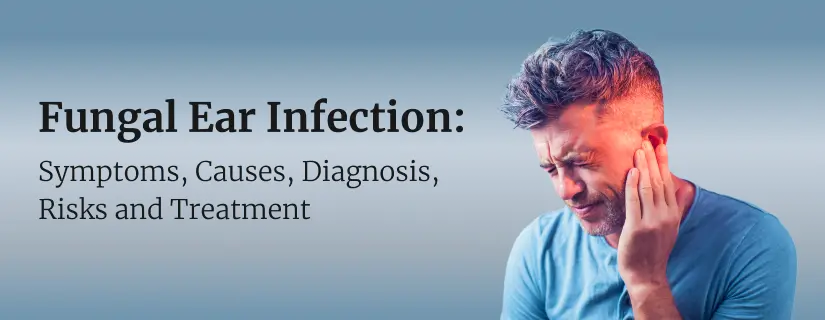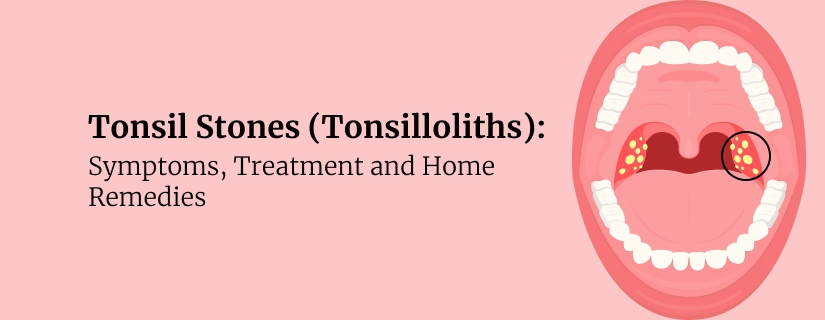-
Doctors
-
Specialities & Treatments
Centre of Excellence
Specialties
Treatments and Procedures
Hospitals & Directions HyderabadCARE Hospitals, Banjara Hills CARE Outpatient Centre, Banjara Hills CARE Hospitals, HITEC City CARE Hospitals, Nampally Gurunanak CARE Hospitals, Musheerabad CARE Hospitals Outpatient Centre, HITEC City CARE Hospitals, Malakpet
HyderabadCARE Hospitals, Banjara Hills CARE Outpatient Centre, Banjara Hills CARE Hospitals, HITEC City CARE Hospitals, Nampally Gurunanak CARE Hospitals, Musheerabad CARE Hospitals Outpatient Centre, HITEC City CARE Hospitals, Malakpet Raipur
Raipur
 Bhubaneswar
Bhubaneswar Visakhapatnam
Visakhapatnam
 Nagpur
Nagpur
 Indore
Indore
 Chh. Sambhajinagar
Chh. SambhajinagarClinics & Medical Centers
Book an AppointmentContact Us
Online Lab Reports
Book an Appointment
Consult Super-Specialist Doctors at CARE Hospitals
Fungal Ear Infection: Symptoms, Causes, Diagnosis, Risks and Treatment
Updated on 29 December 2023

Table of Content
- What is a Fungal Ear Infection?
- Fungal Ear Infection Symptoms
- Fungal Ear Infection Causes
- Risk Factors for Fungal Ear Infection
- Diagnosis of Fungal Ear Infection
- Medical Tests Required for Fungal Ear Infection
- Fungal Ear Infection Treatment
- Home Remedies for Fungal Infection in Ear
- Preventing Fungal Ear Infection
- Conclusion
Infection in the ear caused by fungus is also known by the medical term - Otomycosis. It mostly affects the outer ear, most commonly the ear canal. Fungi thrive in warm environments; therefore, fungal ear infections are quite common in the summer, and they need to be treated with medications.

What is a Fungal Ear Infection?
Fungi, a parasite, start to thrive in the ear canal of the outer ear region, causing problems with hearing along with itching. It is usually referred to as a fungal ear infection or Otomycosis. Mostly, Candida and Aspergillus fungi lead to fungal infection inside ear. Sometimes, the outer ear with fungal infection can spread to the middle ear, but it is not quite common.
The reason for fungal infection in ear is warm temperatures and humid weather. The summertime provides the perfect weather for fungus to thrive. Sometimes, people who swim or participate in watersports frequently are more prone to a fungal ear infection.
Fungal Ear Infection Symptoms
The signs of fungal ear infection may be present in a single or both ears. Although these signs may vary from person to person, the most common fungal ear infection symptoms may include the following.
- Pain in the ear
- Intense itching
- Burning pain
- Flakiness around the ear canal
- Inflammation of the outer ear
- Yellow, green, black, white, or grey discharge
- Discoloration of the outer ear
- The feeling of fullness in the ear
- Ringing in the ear (tinnitus)
- Hearing loss
Sometimes, some people may even experience headaches, dizziness, severe pain in the ear, and even fever. Based on the type of fungus affecting the ear, different signs may be visible. If Aspergillus fungi are the primary cause of the ear infection, yellow or greyish-black dots surrounded by cotton-like fungal spores may be visible, most commonly in the ear canal. Thick, creamy white fungal ear infection discharge may be visible if the candida fungus has caused the ear infection.
Fungal Ear Infection Causes
Fungal ear infection is caused by mainly two types of fungi, namely, Aspergillus and Candida. The most common fungus to cause fungal ear infections is Aspergillus, which is about 90% of the time. Both Aspergillus and Candida are found naturally in the environment. We breathe Aspergillus in and out all the time without any trouble, and Candida fungus is commonly found on the skin and even inside the body. However, some strains of Candida may cause fungal infections, while Aspergillus may cause health problems in some people with weakened immune systems.
Risk Factors for Fungal Ear Infection
The earwax present in the ear canal provides protection to the ear canal presenting a water-resistant covering. When the amount of earwax in the ear canal reduces, it can make the outer ear vulnerable to infections of various kinds. Some risk factors that may increase the likelihood of getting a fungal ear infection may include:
- Getting water inside the ear when swimming or diving
- Injuring the ear canal while trying to clean using cotton swabs
- Constant use of earplugs or earphones without cleaning them properly
- Getting chemicals or irritants like hair dyes or hair sprays and gels in the ear
- Being associated with watersports frequently
- Having eczema or other skin conditions of the ear
- Having ear trauma or injuries
- Having a weak immunity
While fungal ear infection is not contagious, meaning it cannot be spread from person to person, the fungus may spread through water when coming in contact with a person's ear.
Diagnosis of Fungal Ear Infection
Fungal infection in the ear treatment may be done based on diagnosis through physical examination and specific testing. Primarily, an otoscope may be used to look inside the ear canal of the infected person. An otoscope is a magnifying device that can be used to look inside the ear. The healthcare provider may also ask for the symptoms and medical history of the infected person.
Medical Tests Required for Fungal Ear Infection
If there is any pus or discharge from the infected ear, the healthcare provider may use a swab to take a sample of the discharge and send it for further testing in the laboratory. This sample may help to identify the microorganisms responsible for the ear infection.
Fungal Ear Infection Treatment
There are several treatment options available for fungal ear infections. The concerned doctor may best determine the right treatment.
- Cleaning: Primary treatment of fungal ear infection may be cleaning of the infected ear using special rinses to remove any discharge or debris. It is not recommended to try cleaning the infected ear at home as it may further aggravate the condition.
- Medicines: Healthcare providers may recommend certain antifungal medicines for ear fungal infection. If required, pain relievers may also be recommended to provide relief from any discomfort.
- Ear Drops: Antifungal ear drops may be recommended by a healthcare provider to treat a fungal ear infection and reduce inflammation of the ear canal.
- Creams or Ointments: Topical creams or ointments may also be recommended to be applied to the external ear region rather than inside the ear canal, particularly as a potential fungal infection behind ear treatment.
Home Remedies for Fungal Infection in Ear
Sometimes, fungal ear infection treatment at home may provide relief to the symptoms of infection. However, such remedies should not be tried without consulting a doctor first.
- Wash it with cold water
- Neck stretches can work great in reducing pain and itching
Preventing Fungal Ear Infection
It is not always possible to prevent a fungal ear infection, but some fungal infections in the ear home remedy may be beneficial to reduce the risk of having an infection. These tips may help to reduce the risk of fungal ear infections:
- Cleaning earplugs and/or earphones regularly
- Wearing earplugs when swimming or going in water
- Drying the ear with a hairdryer after showering, especially if water is stuck in the ear canal
- Avoiding scratching and poking inside the ear canal in an attempt to clean it
Conclusion
Usually, it takes about 1 to 2 weeks before a fungal ear infection starts to improve with treatment. Sometimes, a person may experience a situation where a fungal ear infection keeps coming back. In such a condition, it is important to take precautions to prevent such infections and get them treated by the ENT specialist as and when fungal infections occur in the ear.

ENQUIRY FORM
SELECT CATEGORIES
-
Neurosciences (16)
-
Neurology (37)
-
Neurosurgery (14)
-
Orthopaedics (48)
-
Oncology (33)
-
Obstetrics and gynecology (51)
-
Pulmonology (23)
-
Urology (20)
-
Nephrology (13)
-
Psychiatry (7)
-
Dietetics and Nutrition (111)
-
General Medicine (63)
-
Cardiac Sciences (30)
-
Vascular & Endovascular Surgery and Interventional Radiology (10)
-
Gastroenterology (46)
-
Endocrinology (23)
-
Plastic Surgery (10)
-
Critical Care Medicine (5)
-
COVID-19 (16)
-
Dermatology (16)
-
Emergency Care (1)
-
Ophthalmology (4)
-
Pediatrics (14)
-
Laparoscopic and Bariatric Surgery (8)
-
ENT (15)
-
Kidney Transplant (1)
-
Liver Transplantation and Hepatobiliary Surgery (5)
-
General Surgery (3)
-
Internal Medicine (5)
-
Medicine Information
6 Home Remedies to Get Rid of Continuous Hiccups
Whooping Cough: Symptoms, Causes, Diagnosis, Prevention and Treatment
YOU MAY ALSO LIKE
RECENT BLOGS
-

Direct Anterior Approach in Total Hip Replacement: Advantages and Challenges
10 April 2025
Read More
-

Zinc Deficiency: Signs and Symptoms, Causes, Treatment
9 April 2025
Read More
-

Chest Pain When Coughing: Causes, Treatment and Home Remedies
9 April 2025
Read More
-

12 Health Benefits of Eating Mushrooms
8 April 2025
Read More
-

7 Health Benefits of Blood Donation You Should Know About
8 April 2025
Read More
-

Implantation Bleeding Vs Periods: Know the Difference
28 February 2025
Read More
-

Bloating During Ovulation: Symptoms, Causes and Remedies
28 February 2025
Read More
-

Itching During Dengue: Causes, Treatment and Home Remedies
18 February 2025
Read More
Have a Question?
If you cannot find answers to your queries, please fill out the enquiry form or call the number below. We will contact you shortly.













